Test Pipeline Writing Guideline and Samples
The Test Pipeline is one of the most important elements on the Testany Platform. For a detailed definition, refer to the Glossary. Efficient use and maintenance of the Test Pipeline can significantly enhance your automation testing efficiency as well as improve the accuracy and efficiency of troubleshooting.
https://www.youtube.com/watch?v=NqjWvCSWXzg
Please select your preferred subtitle language.
Preparation:
Pipeline is used to orchestrate test cases. Each test case registered in Testany will have a unique case key , you can use these keys to build your pipeline.
You can get the related Test Case Key from Test Case Library

In this example, you have 6 different test cases. And we’ll use 4 of them, which the keys are: AC2F5A50, 9686C618 , 43D41CA4 and 8FF75E7F
Get to know Pipeline YAML
In the Testany platform, a pipeline is used to express the logical relationships and other associated factors between the test cases within that pipeline during execution. To ensure precise and unambiguous representation, the pipeline shall strictly adhere to the structural rules and constraints of a MULTI-WAY TREE from a data structure perspective. Additionally, for ease of authoring and maintaining pipelines, we have chosen YAML as the format for defining pipelines.
Write Pipeline yaml file
On the Testany Platform, we use YAML files with a predefined syntax format to define pipelines, which we also refer to as Pipeline Orchestration. For Pipeline orchestration, you need to follow the format bellow (as of rule/v1.2):
run: defined execute which Test CasewhenPassed: defined a condition, means when Test Case<TEST-CASE-KEY>executed withPassedstatus, then invokerundefined test casewhenFailed: defined a condition, means when Test Case<TEST-CASE-KEY>executed withFailedstatus, then invokerundefined test caseexpect: fail: this used for change test case execution status. For pipeline execution status definition, all the executed test case execution status withPassed, then pipeline execution status isPassed, otherwise, the pipeline execution status isFailed. If some test case which executed status isFailed, and theFailedstatus is expected, you want to change it asPassedto make pipeline execution status withSuccess, you can use this.relay: test case with this attribute can pass the value of its pre-declared variable(s) as input to other cases within the same pipeline upon its execution completion.rule/v1.2should be used.
kind: rule/v1.2
spec:
rules:
- run: <TEST-CASE-KEY>
- whenPassed: <TEST-CASE-KEY>
run: <TEST-CASE-KEY>
- whenFailed: <TEST-CASE-KEY>
run: <TEST-CASE-KEY>
- whenFailed: <TEST-CASE-KEY>
run: <TEST-CASE-KEY>In this case, the pipeline.yaml should be:
kind: rule/v1.2
spec:
rules:
- run: AC2F5A50
- whenPassed: AC2F5A50
run: 9686C618
- whenFailed: 9686C618
run: 43D41CA4
- whenFailed: 9686C618
run: 8FF75E7FThat means
invoke AC2F5A50
if AC2F5A50 executed with Passed result then
invoke 9686C618
if 9686C618 executed with Failed result then
invoke 43D41CA4
invoke 8FF75E7F
else
pipeline completed
else
pipeline completedPipeline Flow Diagram:
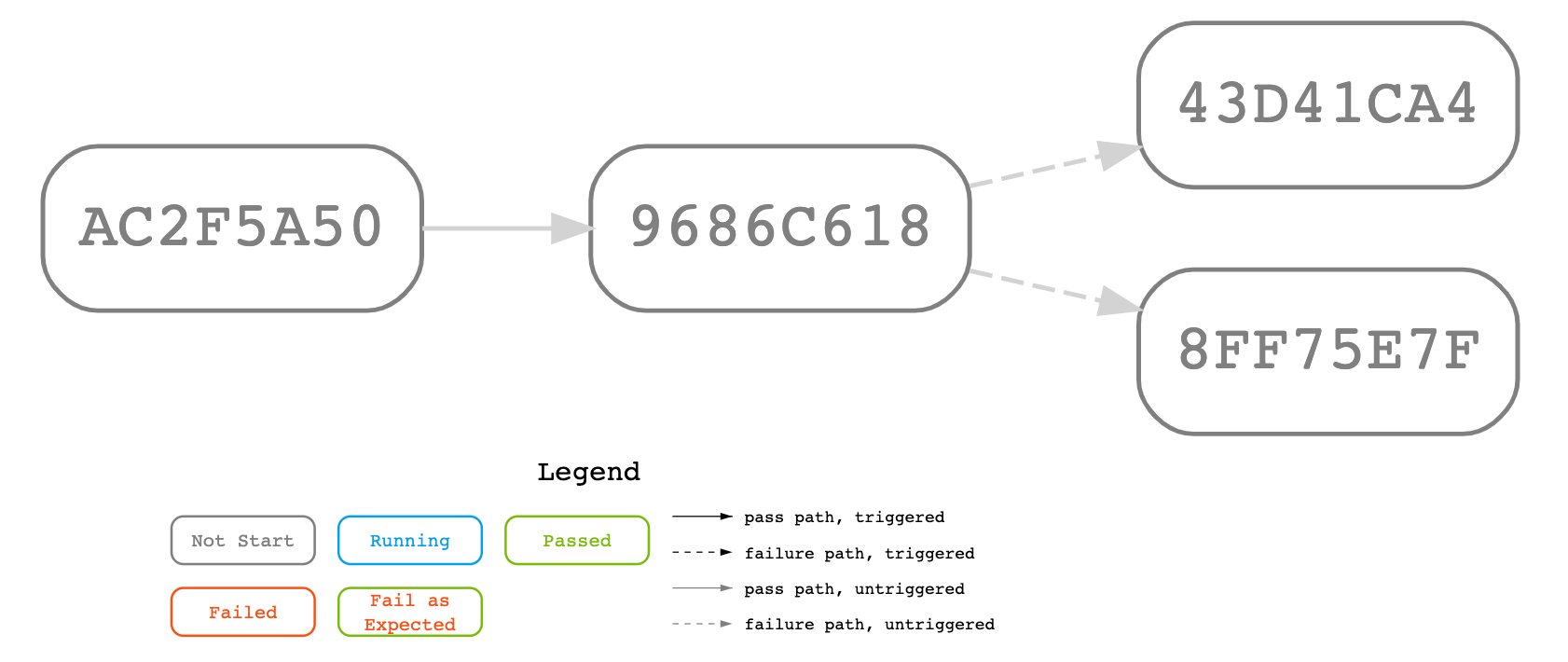
Rules of Pipeline Execution Result
When the pipeline is orchestrated and executed, it will generate a Pipeline Execution Status. For detailed definitions of the statuses and the conditions under which they appear, please refer <Understanding Statuses on Testany Platform: Your Comprehensive Guide> .
In relation to the example above: if AC2F5A50 executed with Passed, and 9686C628 executed with Passed then pipeline status is Success, otherwise the pipeline status would be Failure .
In our actual testing work, there is a relatively special situation where we know very clearly that a particular test case will result in a Failed outcome, and this result is expected (for example, when the test script is ready before the code being tested). For this situation, Testany specifically provides a syntax: expect: fail .
For example, in below yaml, you know 9686C618 will be executed with Failed and that Failed is expected, so apparently you want to pipeline execution status with Success even 9686C618 is Failed, you can add expect: fail after run:9686C618 (line 7):
kind: rule/v1.2
spec:
rules:
- run: AC2F5A50
- whenPassed: AC2F5A50
run: 9686C618
expect: fail
- whenFailed: 9686C618
run: 43D41CA4
- whenFailed: 9686C618
run: 8FF75E7FPipeline examples:
Let’s use a few examples to further illustrate how to orchestrate a pipeline that meets testing requirements and business logic, making your automated testing more accurate and efficient.
Sample A (valid): run single case with whenFailed
Scenario: “When the previous case fails, execute the next case.”
Pipeline Yaml:
kind: rule/v1.2
spec:
rules:
- run: AC2F5A50
- whenFailed: AC2F5A50
run: 9686C618
- whenFailed: 9686C618
run: 43D41CA4
- whenFailed: 43D41CA4
run: 8FF75E7FFlow diagram

Sample B (valid): run single case with whenPassed
Scenario: “When the previous case pass, execute the next case.”
Pipeline Yaml:
kind: rule/v1.2
spec:
rules:
- run: AC2F5A50
- whenPassed: AC2F5A50
run: 9686C618
- whenPassed: 9686C618
run: 43D41CA4
- whenPassed: 43D41CA4
run: 8FF75E7FFlow diagram

Sample C (valid): run multi-cases with whenFailed
Scenario: “When the previous case failed, execute the next 3 cases.”
Pipeline Yaml:
kind: rule/v1.2
spec:
rules:
- run: AC2F5A50
- whenFailed: AC2F5A50
run: 9686C618
- whenFailed: AC2F5A50
run: 43D41CA4
- whenFailed: AC2F5A50
run: 8FF75E7FFlow diagram

Sample D (valid): run without condition
Scenario: “Regardless of the outcome, execute all four cases in the sequence from top to bottom that stated in YAML file.”
Pipeline Yaml:
kind: rule/v1.2
spec:
rules:
- run: AC2F5A50
- run: 9686C618
- run: 43D41CA4
- run: 8FF75E7FFlow diagram:
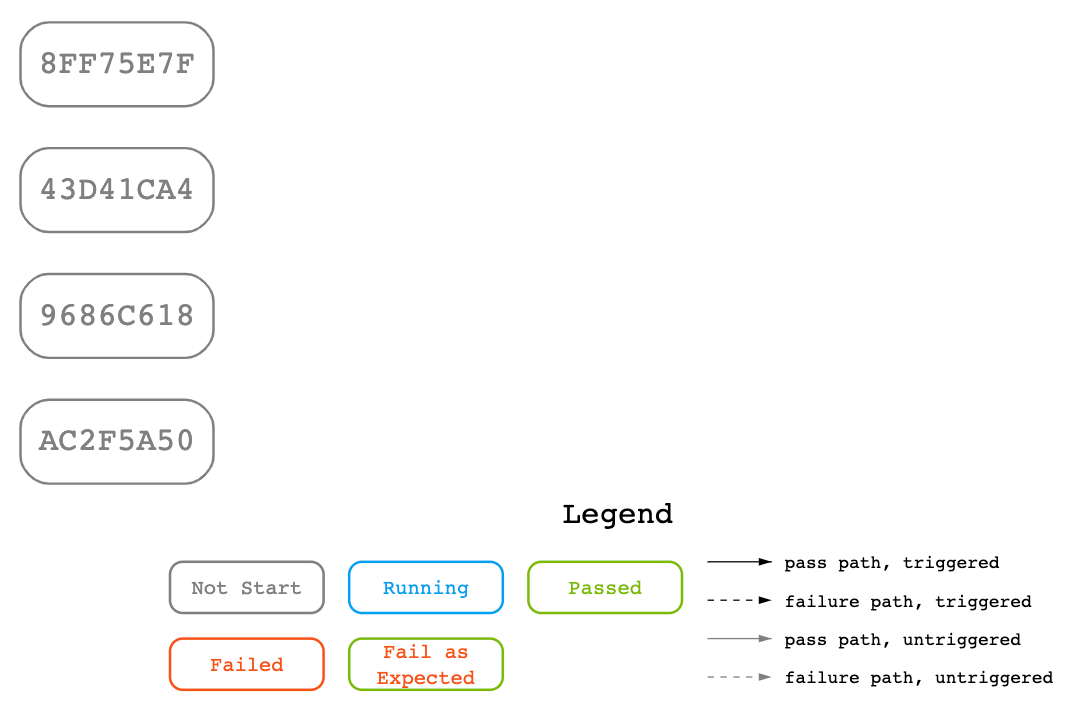
Sample E (valid): run with relay + whenPassed
Scenario: “This is a standard and valid output relay sample. Case DE96D6A0 get ACCESS_TOKEN from case 5DC1106D, case 3FD642B7 also get ACCESS_TOKEN from 5DC1106D. Output relay is from 5DC1106D to DE96D6A0, and from 5DC1106D to 3FD642B7.”
Pipeline Yaml:
kind: rule/v1.2
spec:
rules:
- run: F8C8B1EA
- whenPassed: F8C8B1EA
run: 5DC1106D
- whenPassed: 5DC1106D
run: DE96D6A0
relay:
- key: ACCESS_TOKEN # Define an environment variable 'ACCESS_TOKEN' for case 'DE96D6A0'
refKey: 5DC1106D/ACCESS_TOKEN # Set case 'DE96D6A0's 'ACCESS_TOKEN' equal to case '5DC1106D's 'ACCESS_TOKEN'
- whenPassed: 5DC1106D
run: 3FD642B7
relay:
- key: ACCESS_TOKEN # Define an environment variable 'ACCESS_TOKEN' for case '3FD642B7'
refKey: 5DC1106D/ACCESS_TOKEN # Set case '3FD642B7's 'ACCESS_TOKEN' equal to case '5DC1106D's 'ACCESS_TOKEN'
- key: STATUS # Define an environment variable 'STATUS' for case '3FD642B7'
refKey: F8C8B1EA/STATUS # Set case '3FD642B7's 'STATUS' equal to case 'F8C8B1EA's 'STATUS'
nonSecret: true # Set case '3FD642B7's 'STATUS' as non-secret (its value can be printed out in log)Flow diagram:
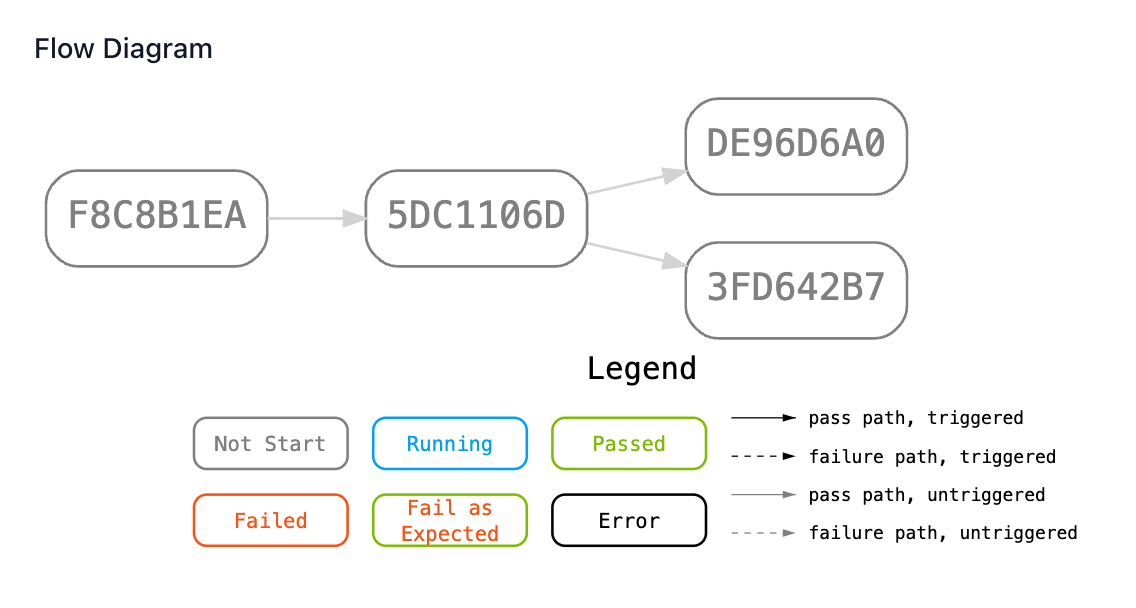
Sample F (invalid): run with both relay and whenFailed
Scenario: “User defines in the YAML that case B both Relays case A and includes whenfailed: A, the system would consider the YAML as invalid.”
Pipeline Yaml:
kind: rule/v1.2
spec:
rules:
- run: 5385B189
- run: A3D9405F
whenFailed: 5385B189
relay:
- key: NEW_URL
refKey: 5385B189/NEW_URL
nonSecret: true
- key: AAA
refKey: 5385B189/AAA
nonSecret: true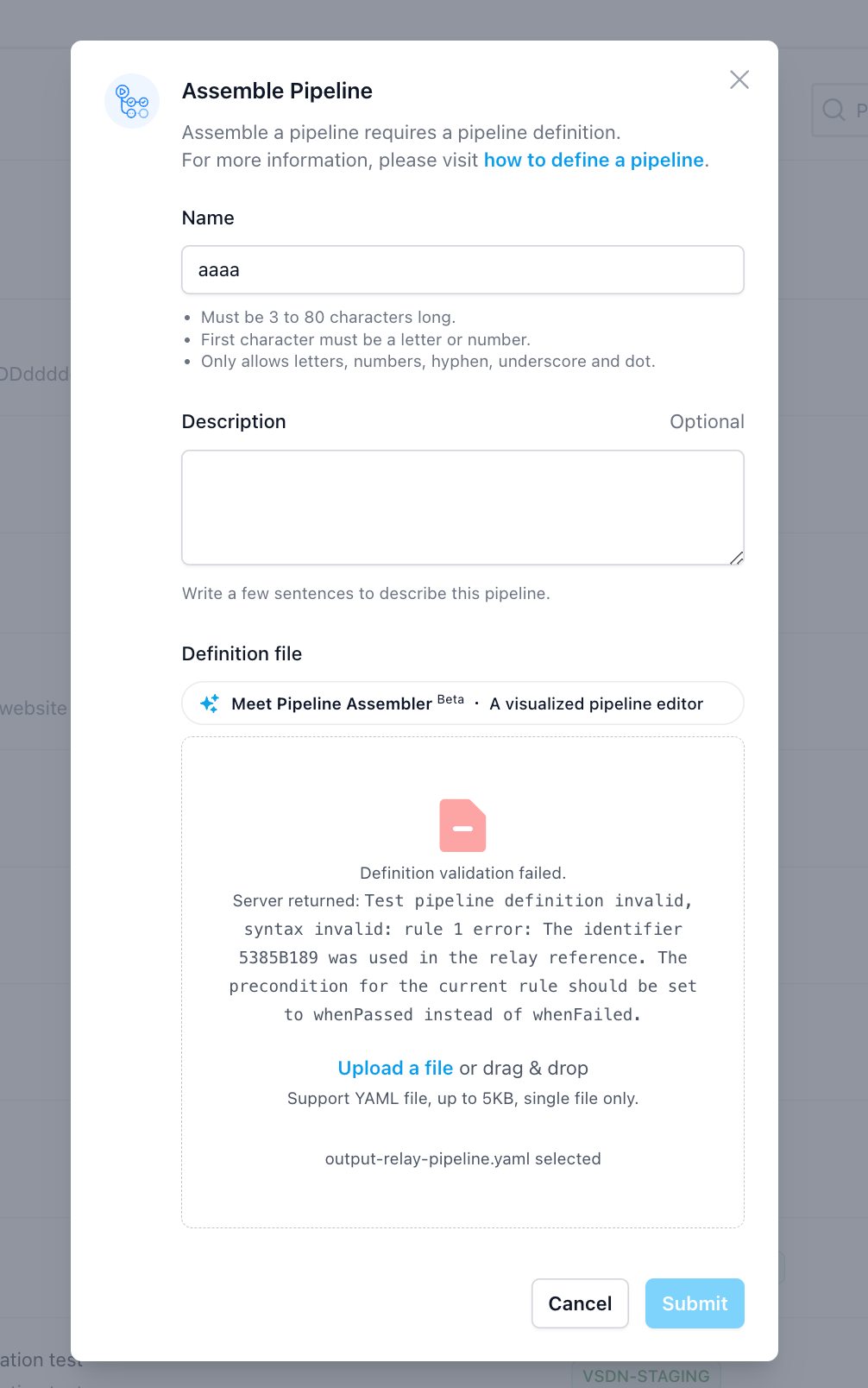
Sample G (valid): run with relay
Scenario: ”User explicitly defines in the YAML that B Relays A but does not explicitly declare other whenpassed or whenfailed for B, the system should implicitly add whenpassed: A .”
Pipeline Yaml:
kind: rule/v1.2
spec:
rules:
- run: 5385B189
- run: A3D9405F
relay:
- key: NEW_URL # Define an environment variable 'NEW_URL' for case 'A3D9405F'
refKey: 5385B189/NEW_URL # set case 'A3D9405F' 's 'NEW_URL' equal to case '5385B189' 's 'NEW_URL'
nonSecret: true
- key: AAA # Define an environment variable 'AAA' for case 'A3D9405F'
refKey: 5385B189/AAA # set case 'A3D9405F' 's 'AAA' equal to case '5385B189' 's 'AAA'
nonSecret: true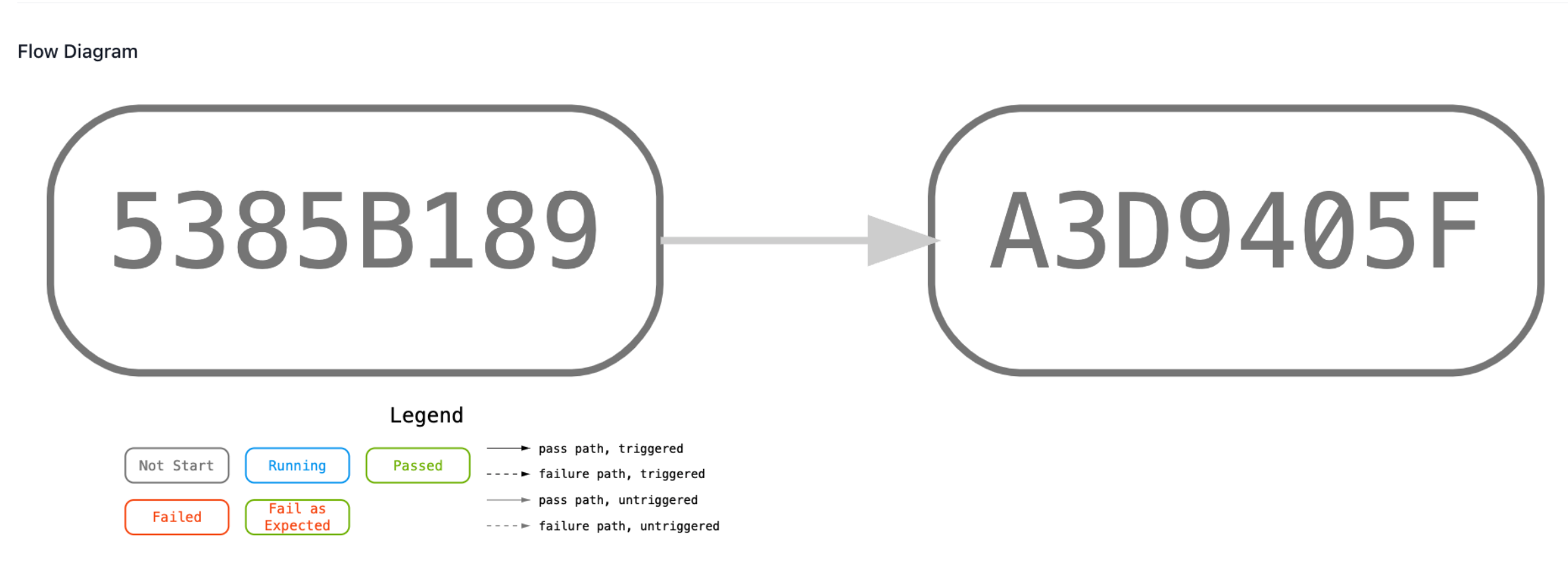
Sample H (invalid): relay is not set in case detail
Scenario: ”Case B depends on the output of Case A, but Case A does not declared any output. In this case, the system will not reject the configuration, but in the pipeline details page user will not see any test cases marked with the Relay Output Case flag. It reminds user to review the dependency settings.”
Pipeline Yaml:
kind: rule/v1.2
spec:
rules:
- run: 4035A27B
- run: D2ADC651
relay:
- key: ACCESS_TOKEN
refKey: 4035A27B/ACCESS_TOKEN
Case A with relay configured.

Case A without relay configured.

Sample I (invalid): interdependent cases
Scenario: ”Cases that depends on each other in a cycle, in that case the system would consider the YAML as invalid. ”
Pipeline Yaml:
kind: rule/v1.2
spec:
rules:
- whenPassed: 9D9671B4
run: 714A0A51
- whenPassed: 714A0A51
run: D2ADC651
- whenPassed: D2ADC651
run: 9D9671B4
